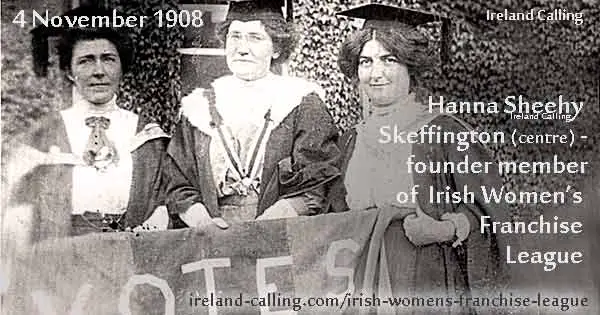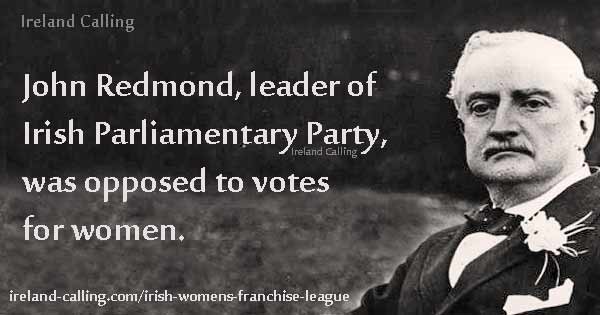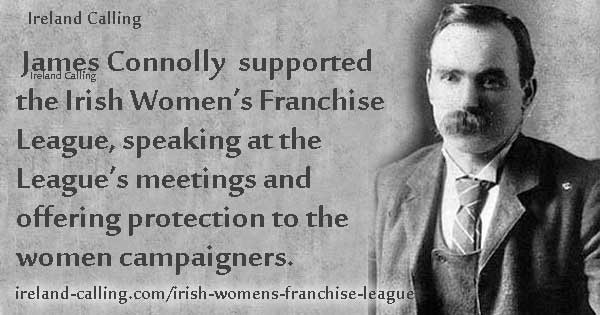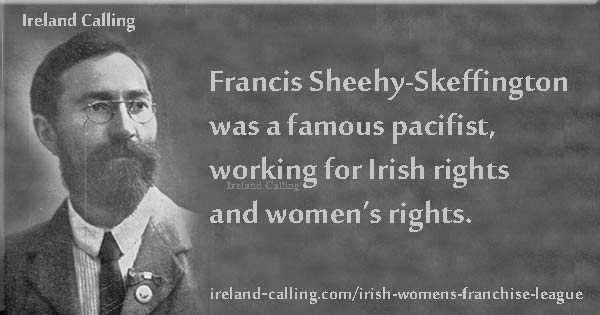It’s hard to imagine now that less than a hundred years ago women were not allowed to vote in Ireland and most other countries across the world.
Not only that but they were treated like second class citizens in terms of their civil rights, social standing and employment opportunities.

They had no say in how their country was governed or how laws affecting them should be changed. By the turn of the 19th century women across the western world were campaigning for greater equality.
In Ireland, women like Hannah Sheehy-Skeffington, one of Ireland’s leading suffragettes and peace activists, devoted their lives fighting the right to vote. It was no easy task.
Skeffington became one of the founder members of the Irish Women’s Franchise League, which was established in Dublin on 4 November, 1908. Her husband Francis Sheehy-Skeffington was also a founder member and offered his full support.
Irish leader and British PM opposed votes for women
Not all men at the time were so helpful. The British Prime Minister Herbert Asquith was opposed to votes for women. The leader of the Irish Parliamentary Party, John Redmond, felt the same, as did many men at the time.

The Franchise League faced widespread hostility from the middle class establishment, which was completely dominated by men who wanted to maintain their position of power. The women were derided by politicians and press barons, and harassed by police as they staged their meetings and protest marches.
The women set up their own newspaper, the Irish Citizen, to publicise their cause but they were also prepared to engage in direct action.
Sheehy-Skeffington and several other members of the Franchise League were arrested and jailed in June 1912 after smashing windows in the General Post Office and various government buildings in Dublin.
In July 1912, Prime Minister Asquith visited Ireland and was constantly confronted by the League and their supporters. His carriage was surrounded by suffragettes who had travelled across from Britain. In the scuffles, Redmond was injured. The women were arrested and sent to Mountjoy Jail where they staged a hunger strike in protest.
Women from the Irish Franchise League, who were also in Mountjoy Jail, joined the hunger strike as a show of solidarity with their British colleagues.
Redmond maintained his opposition to votes for women and opposed a Women’s Franchise Bill in the British parliament.
Easter Rising proclamation promised equal rights
Not all prominent men were against the women’s cause. James Connolly became leader of the Irish Transport and General Workers Union in 1913 and was happy to lend his support. He spoke at the League’s meetings and his Irish Citizen Army, formed to support trade unionists, sometimes stood guard at meetings and offered protection to the women campaigners.

Connolly was one of the leaders who was executed for his part in the 1916 Easter Rising. Like him, most of the other leaders of the Rising were also sympathetic to the Franchise League, and their Proclamation of the Irish Republic promised equal rights for all men and women.
In 1918, the campaigners secured the first stage of their victory. The British parliament gave women the right to vote as long as they were over the age of 30 and owned a property. In practice, this was something of an empty victory as very few women owned property. Their homes would invariably be in their husband’s name.
Women in Ireland benefited from the creation of Irish Free State. Like the leaders of the Easter Rising, most Irish nationalists welcomed equal rights for women.
In 1922, the new Free State government extended the right to vote to all women in Ireland over the age of 21, putting them on an equal footing with men.
Voting rights introduced in stages across the world
Other countries followed. Voting rights were introduced in stages at first but by 1920, women in the United States were able to vote – although, this right wasn’t widely available to all black women until the mid-1960s.
All women in the UK got the right to vote in 1928. The process was more drawn out in Canada, with voting rights being granted separately by the various provinces between 1916 and 1940.
Women in Australia also won the right to vote at different times in different regions, between 1865 and 1908. However, aboriginal women didn’t get full voting rights until 1962. Despite these early successes, the road towards equal rights for women has been slow and arduous. Women in Kuwait only won the right to vote in 2005, and even then they had to agree to abide by Islamic Law.
In several countries across the world, women still have very few rights and are still treated as subservient, second class citizens. And even in the western democracies, many would argue that women still aren’t truly equal in terms of rights and opportunities.
Some favourite quotes from the women of Ireland
More history articles
The Neolithics – first people to leave their mark on Ireland
